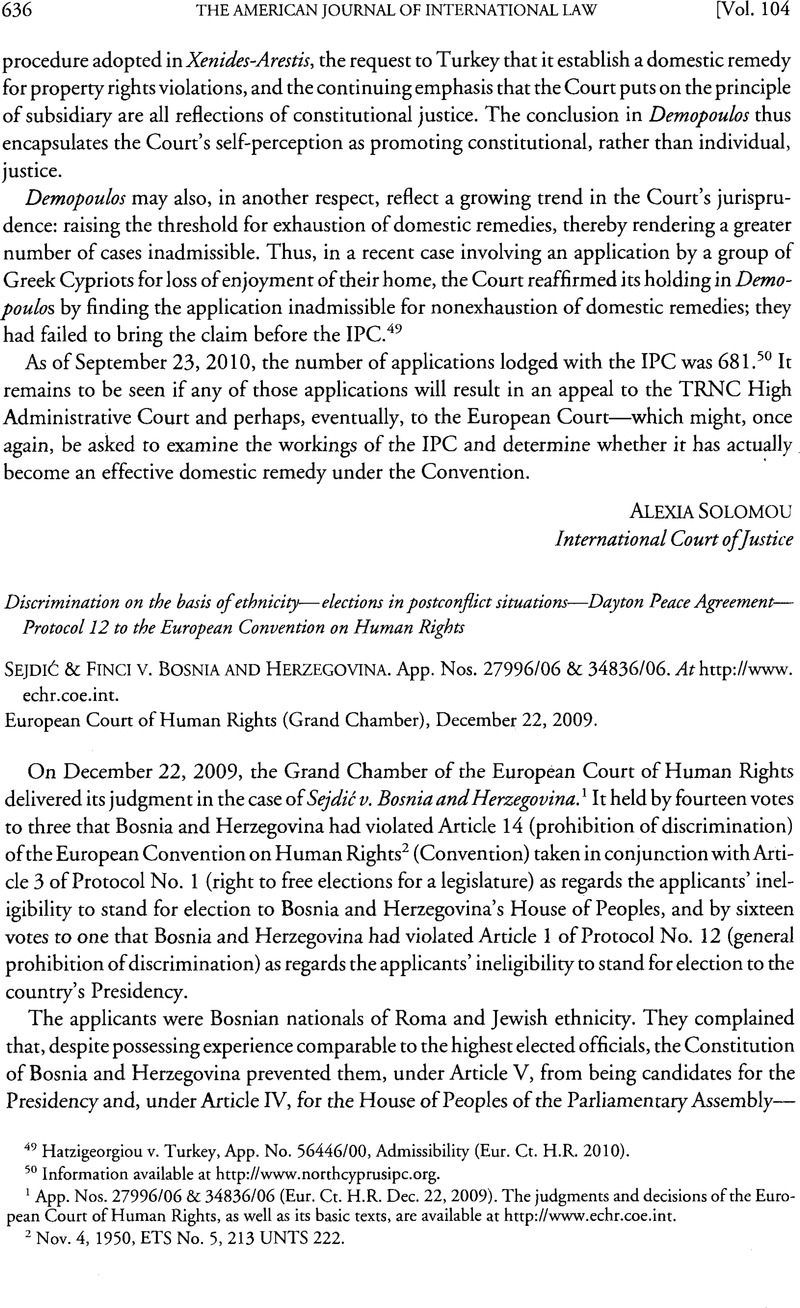Article contents
Sejdić & Finci v. Bosnia and Herzegovina
Published online by Cambridge University Press: 27 February 2017
Abstract

- Type
- International Decisions
- Information
- Copyright
- Copyright © American Society of International Law 2010
References
1 App. Nos. 27996/06 & 34836/06 (Eur. Ct. H.R. Dec. 22, 2009). The judgments and decisions of the European Court of Human Rights, as well as its basic texts, are available at http://www.echr.coe.int.
2 Nov. 4, 1950, ETS No. 5, 213 UNTS 222.
3 General Framework Agreement for Peace in Bosnia and Herzegovina, Dec. 14, 1995, Bosn. & Herz.-Croat.- Yugo., 35ILM75 (1996). Annex 4 sets out the Constitution of Bosnia and Herzegovina, Articles IV and V of which define the eligibility for the House of Peoples and the Presidency.
4 Article 14 provides: “The enjoyment of the rights and freedoms set forth in this Convention shall be secured without discrimination on any ground such as sex, race, colour, language, religion, political or other opinion, national or social origin, association with a national minority, property, birth or other status.”
5 Article 3 provides: “The High Contracting Parties undertake to hold free elections at reasonable intervals by secret ballot, under conditions which will ensure the free expression of the opinion of the people in the choice of the legislature.”
6 Article 1 provides:
-
The enjoyment of any right set forth by law shall be secured without discrimination on any ground such as sex, race, colour, language, religion, political or other opinion, national or social origin, association with a national minority, property, birth or other status.
-
No one shall be discriminated against by any public authority on any ground such as those mentioned in paragraph 1.
7 In this context the Court mentioned the following:
[I]n 2005 the former parties to the conflict surrendered their control over the armed forces and transformed them into a small, professional force; in 2006 Bosnia and Herzegovina joined NATO’s Partnership for Peace; in 2008 it signed and ratified a Stabilisation and Association Agreement with the European Union; in March 2009 it successfully amended the State Constitution for the first time; and it has recently been elected a member of the United Nations Security Council for a two-year term beginning on 1 January 2010. (Para. 47)
8 The Court had to rely on Protocol No. 12 because the Presidency could not be defined as a “legislature” within the meaning of Article 3 of Protocol No. 1, and thus fell outside the scope of that provision. While the Article 14 prohibition of discrimination applies specifically to “the rights and freedoms set forth in this Convention”—that is, is solely accessory or parasitic in character—the one in Protocol No. 12 extends to all rights recognized by law. It is precisely the breadth of this prohibition and its implications for vast areas of economic and social policy that have led many states to balk at ratifying the Protocol. See generally Jams, Mark W., Kay, Richard S., & Bradley, Anthony W., European Human Rights Law: Text and Materials 457-69, 516-18 (2008)Google Scholar. As of July 12, 2010, only eighteen of forty-seven states parties to the Convention have ratified Protocol No. 12, which went into force (after ten ratifications) on April 1, 2005.
9 Case No. U-5/04, Admissibility, para. 13 (Const. Ct. Bosn. & Herz. Mar. 31,2006). The decisions of the Constitutional Court are available at http://www.ccbh.ba/eng/odluke/.
10 Case No. U-13/05, Admissibility (Const. Ct. Bosn. & Herz. May 26, 2006).
11 Case No. AP-2678/06, Admissibility & Merits (Const. Ct. Bosn. & Herz. Sept. 29, 2006).
12 Id., Sep. Concurring Op. Feldman, J., para. 4.
13 Id., para. 5.
14 Id.
15 See generally Int’l L. Comm’n, Fragmentation of International Law: Difficulties Arising from the Diversification and Expansion of International Law, Report of the Study Group on the Fragmentation of International Law, Finalized by Maarti Koskenniemi, UN Doc. A/CN.4/L.682 (Apr. 13, 2006).
16 See more Marko, Milanovic, Norm Conflict in International Law: Whither Human Rights? 20 Duke J. Comp. & Int’l L. 69 (2009)Google Scholar.
17 See Constitution of Bosnia and Herzegovina Art. X (annexed to the General Framework Agreement for Peace in Bosnia and Herzegovina, supra note 3).
18 See also Anes, Alic, Ethnic Hysteria and Status Quo Discrimination in Bosnia, Radio Free Europe (May 5, 2010)Google Scholar, at http://www.rferl.org/content/Ethnic_Hysteria_And_Status_Quo_Discrimination_In_Bosnia/2033011.html.
19 Declaration on Bosnia and Herzegovina (May 11, 2010), at http://www.coe.int/t/cm/.
20 Resolution 1725, The Urgent Need for a Constitutional Reform in Bosnia and Herzegovina (Apr. 29, 2010), at http://assembly.coe.int.
21 Resolution of 17 June 2010 on the Situation in Bosnia and Herzegovina, para. 15, at http://www.europarl.europa.eu.
22 Hirst v. United Kingdom (No. 2), 2005-IX Eur. Ct. H.R. 187 (Grand Chamber).
23 See Human Rights Joint Committee Of Parliament, Fifteenth Report: Enhancing Parliament’s Role in Relation to Human Rights Judgments, paras. 99-119 (Mar. 9, 2010)Google Scholar, at http://www.publications.parliament.uk/pa/jt/jtrights.htm.
24 See, e.g., Vienna Convention on the Law of Treaties, Art. 27, May 23, 1969, 1155 UNTS 331.
25 A v. Ireland, App. No. 25579/05, at http://www.echr.coe.int/ECHR/EN/Header/The+Court/The+Court/The+Grand+Chamber.
26 See Anne, Peters, The Swiss Referendum on the Prohibition of Minarets, EJIL: Talk! (Dec. 2, 2009)Google Scholar, at http://www.ejiltalk.org/the-swiss-referendum-on-the-prohibition-of-minarets/.
- 11
- Cited by


